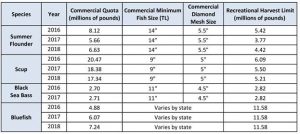April 10, 2018 — The following was released by NOAA Fisheries:
NOAA Fisheries announces three administrative changes to the Mid-Atlantic Fishery Management Council’s processes in setting catch limits though the Acceptable Biological Catch Omnibus Framework Adjustment:
- The Council may now recommend multi-year Acceptable Biological Catch (ABC) limits for Mid-Atlantic fisheries, which may bring greater stability and predictability to the fishing industry;
- The Atlantic Bluefish, Tilefish, and Atlantic Mackerel, Squid, and Butterfish Fishery Management Plans will now automatically incorporate the best available scientific information in calculating ABCs (as all other Mid-Atlantic management plans do) rather than requiring a separate management action to adopt them; and
- New language clarifies the process for setting ABCs for each of the four types of ABC control rules.
To get all the details on these management changes, read the final rule as filed in the Federal Register today.


